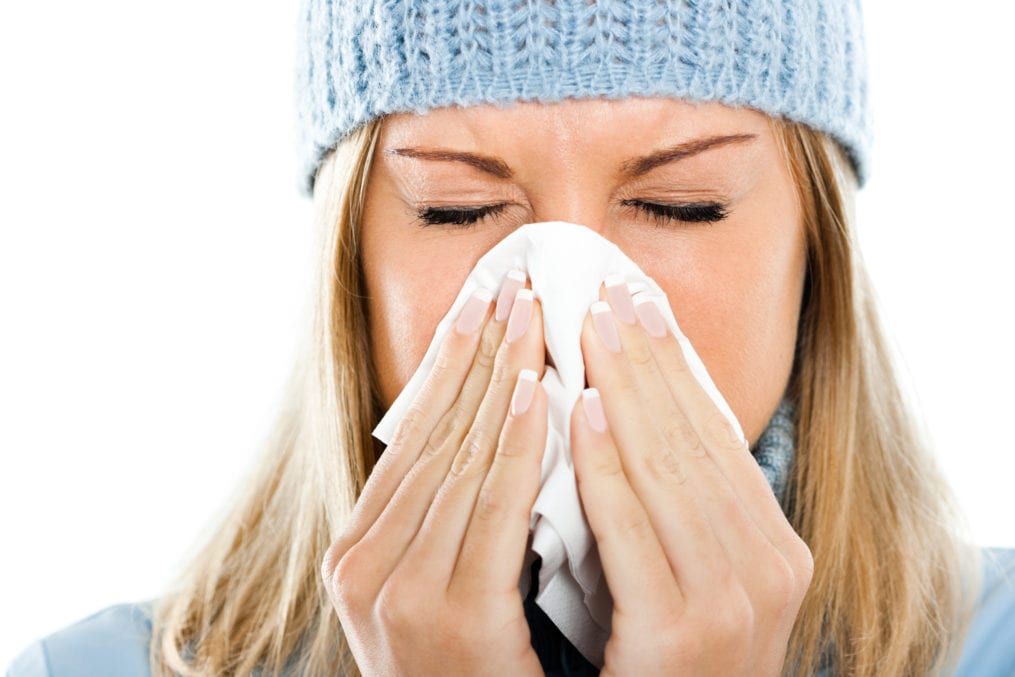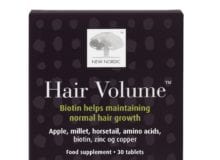Get ready: it’s coughs and sneezes season

It’s easy to dismiss sore throats and sniffles as ‘just’ a cold, but they can really knock you for six – and it’s at this time of year we’re most at risk. With advice from Professor Ron Eccles, Director of the Common Cold Centre at Cardiff University, we’ve explored what causes the common cold – and what you can do to fight back.
Around 100-200 viruses are involved in the common cold, an infection during which the mucous membrane of the nose and throat become inflamed, causing a runny or blocked nose, and a sore throat.
READ MORE: How can I protect my skin from pollution?
The most common of these is the rhinovirus (nose virus). The influenza viruses can cause cold symptoms too and finally the RSV virus can lead to colds in healthy adults, although it can cause more severe lung infections in babies and the elderly.
An influenza virus may just give you cold symptoms, but if it develops into full-blown ‘flu’, this can lead to symptoms including fever, cough, malaise and muscle aches, often with a blocked nose and sore throat. Generally, if influenza isn’t going around the community, you’re unlikely to catch it – although you may feel ‘fluey’ if you have a particularly nasty strain of the common cold.
How colds spread
You may worry about a colleague sneezing near you or someone on public transport coughing, but you’re most likely to catch a cold at home. Duration and proximity of contact are key to the cold virus spreading so you’re much more likely to get it from someone you spend eight hours sleeping next to, or a whole evening snuggling up with on the sofa. If you have a child under the age of five, you’re especially likely to catch a cold from them. Young children are basically bags of viruses because their immune systems are still developing, and they can get 12 colds a year.
You can catch the same cold virus repeatedly because colds and flu don’t cause a big immune response that means your body remembers the virus and fights it off in the future, as is the case with chicken pox, for example. Your resistance to a cold virus you’ve had before may be a bit higher, though, so your symptoms might be less severe next time. It’s also very possible to have two or three different cold viruses at the same time.
It’s important to note there’s a difference between infection and having symptoms. We get far more infections than symptoms. You might have had a dozen infections in the past year but your body may have thrown most of them off so you’ve only experienced cold symptoms twice. It’s the immune response that generates cold symptoms, not the infection itself. It’s actually most common to have an infection without any symptoms. For every two or three people with a cold, there will be 20 more harbouring the infection without symptoms.
How to lower your risk of a cold
Those with lowered immunity – because of chemotherapy, for instance – may want to avoid crowded places like pubs and shopping centres. For the general population, however, these are the best ways to reduce your risk:
- Wash your hands frequently. Cold and flu viruses need to get from nose to nose. They’re passed around in mucus, sometimes from coughs and sneezes but also via hand contact. If you have a cold and virus-infected mucus gets onto your fingers, and you then touch a door handle, you leave the germs on it. When another person comes along and touches the handle, they pick up the virus on their hands. If they then touch their nose or eye, the virus is transferred to them. So washing your hands is the best way to lower your risk.
- Keep warm – especially your nose. Colds are seasonal – there are more around in the winter and that’s probably because our noses get cold. This may sound strange but studies show that if your nose gets cold, any infection you may be harbouring can be triggered and start causing symptoms. In fact, keeping warm overall is important – we’ve done studies that show if your feet get chilled, you’re more likely to develop symptoms. So wrap up warm and hold a scarf loosely over your nose and mouth on cold days.
- Look after yourself. Lack of sleep, stress and poor diet all compromise your immune system and put you at higher risk of a cold. So make good sleep a priority and take steps to deal with stress. Make sure you eat a balanced diet, with plenty of fresh fruit and vegetables.
- Top up with the sunshine vitamin. There’s evidence to show most of us are short of vitamin D during the winter months. The evidence showing supplementing with vitamin D helps prevent colds is fairly weak but it might help and won’t do any harm – I take it myself during the winter.
- Try herbs. There’s evidence Echinacea and pelargonium may help prevent colds. If you’ve taken a herb before and found it helped you avoid a cold that was going around, it’s probably a good idea to stick with it.
- Try a preventative nasal spray. You can buy sprays containing carrageenan, a seaweed extract, which can inactivate the virus, but only if you use it within 24 to 48 hours of symptoms starting.
Treating a cold
If you get a cold or flu, the treatment is the same. You can’t cure it but you can ease symptoms. The first step is to take painkillers like paracetamol, aspirin or ibuprofen. People tend not to think of taking them but they deal with fever, chills, muscle aches, headaches and sore throats so they knock out a lot of the symptoms.
A blocked nose can affect your sleep, which will make you feel worse and affect your immune system, so it’s important to tackle that. Take a decongestant nasal spray to open up the nose. These work for 10 hours so you could have a spray before bed to stop a blocked nose affecting your sleep. For a runny nose and sneezing, sedating antihistamines can help, although they can make you very drowsy so avoid during the day. Or take a multi-symptom cold treatment, which will tackle all the symptoms.
However, you could just take a simple painkiller along with a hot, strong-tasting drink – this will give you relief from a cough and sore throat as it promotes saliva secretions that lubricate the throat and makes your nose run, helping it feel clear. You can have hot drinks as often as you want, which is another advantage. Lemon and honey is ideal as it’s soothing and has a strong flavour. We’ve also found hot blackcurrant is helpful.
When it comes to food, eating curry is a good idea – it works in the same way as hot drinks because the spices promote mucus and saliva secretion. You could wash it with a hot toddy. Don’t have more than one or two units of alcohol, though, as this can actually block up your nose.
Stay in or go out?
Some people think you should stay off work with a cold, but if you have a simple head cold and don’t feel too bad, there’s no need. You can take treatment for your symptoms and carry on as usual – go to work, exercise outdoors, have a swim; it won’t make any difference. Once a cold virus is in the community, people will probably pick it up anyway, so you won’t be preventing your colleagues from catching it. On the other hand, if you have flu-like symptoms, with fever and fatigue, you should rest until you feel up to going out. The best advice is to listen to your body.
What are your favourite cold-busting saviours? Tweet us or tag us on
– we love to hear from you!







